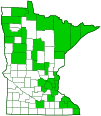dark-spotted palthis
(Palthis angulalis)
Conservation • Description • Habitat • Ecology • Distribution • Taxonomy
|
||||||||
| Hodges # | 8397 |
|||||||
Conservation Status |
||||||||
| IUCN Red List | not listed |
|||||||
| NatureServe | N5 - Secure SNR - Unranked |
|||||||
| Minnesota | not listed |
|||||||
Description |
||
Dark-spotted palthis is a medium-sized litter moth. It occurs across the United States and southern Canada, and in Mexico. It is common in Minnesota. Adults are found from May through August in deciduous and mixed forests. Larvae feed on both living and dead leaves of deciduous and coniferous shrubs and trees, including alder, ash, basswood, birch, willow, pine, and spruce; and of forbs, including aster and goldenrod. Adults are roughly triangular in shape, are 11⁄16″ (18 mm) in length, and have a ¾″ to 1″ (20 to 26 mm) wingspan. The forewings are long and strongly angled on the outer margin, making the outer third distinctly longer than the inner third. They are light tan and are crossed with dark lines and bands. From the wing base to the tip there is an antemedial (AM) line, a median band, a postmedial (PM) line, a subterminal (ST) line, and a terminal line. The AM line is is narrow and jagged. The median band is broad, oblique, and usually dark brown, sometimes orangish-brown. It strongly curves up near the inner margin. It does not reach either the AM line or the leading (costal) margin. The PM and ST lines are jagged. The ST line is often incomplete and sometimes inconspicuous. The terminal line is thin. There is a kidney-shaped spot (reniform spot) above the PM line near the outer (costal) margin. The reniform spot is crescent-shaped, slanting, and dark brown. It is solid, sometimes with an orangish-brown center, but not interrupted with a white line. There is no round spot (orbicular spot) in the upper median area. At the wing tip (apex) on the costal margin there is a rusty-brown outer patch and a yellow inner patch. On the male, the finger-like sensory organs (palps) attached to the mouth are very long, densely hairy, projected forward, and turned upward at the tip. The caterpillar is mottled brown and small, up to ¾″ (2 cm) in length. It is densely covered with minute white spines. There is a low hump on the first abdominal segment (A1) and an angled hump on A8. On A7 there is an oblique white line that continues up the hump on A8, sometimes changing to black on A8. There is a similar but less conspicuous line on A1, A2, and A3 that continue onto A2, A3, and A4 respectively. Mature caterpillars are found from June through fall. |
||
Size |
||
Total length: 11⁄16″ (18 mm) Wingspan: ¾″ to 1″ (20 to 26 mm) |
||
Similar Species |
||
Habitat |
||
Deciduous and mixed forests and woodlands |
||
Ecology |
||
Season |
||
Two generations per year: May through August |
||
Behavior |
||
|
||
Life Cycle |
||
|
||
Larva Hosts |
||
Living and dead leaves of deciduous and coniferous shrubs and trees, including alder, ash, basswood, birch, willow, pine, and spruce; and of forbs including aster and goldenrod. |
||
Adult Food |
||
|
||
Distribution |
||||
|
Sources |
|||
| 12/23/2022 | ||||
Occurrence |
||||
Common in Minnesota |
||||
Taxonomy |
|||
Order |
Lepidoptera (butterflies and moths) | ||
Superfamily |
Noctuoidea (owlet moths and allies) | ||
Family |
Erebidae (underwing, tiger, tussock, and allied moths) | ||
Subfamily |
Herminiinae (litter moths) | ||
Genus |
Palthis | ||
Until recently, the subfamily Herminiinae was treated either as the separate family Herminiidae or as a subfamily of Noctuidae. A molecular phylogenetic analysis of the family Erebidae (Zahiri, Reza; et al., 2011) determined that Herminiinae are closely related to Aganainae, which is a subfamily of Erebidae, and Herminiinae was moved as a whole to Erebidae. |
|||
Synonyms |
|||
|
|||
Common Names |
|||
dark-spotted palthis |
|||
Glossary
Antemedial (AM) line
A thin line separating the basal area and the median area of the forewing of Lepidoptera.
Costal margin
The leading edge of the forewing of insects.
Orbicular spot
A circular spot or outline in the upper median area near the antemedial line on the forewing of many moths.
Postmedial (PM) line
A thin line separating the median area and the postmedial area of the forewing of Lepidoptera.
Reniform spot
A kidney-shaped spot or outline in the lower median area near the PM line on the forewing of many moths.
Visitor Photos |
|||||
Share your photo of this insect. |
|||||
| This button not working for you? Simply email us at info@MinnesotaSeasons.com. Attach one or more photos and, if you like, a caption. |
|||||
Alfredo Colon |
|||||
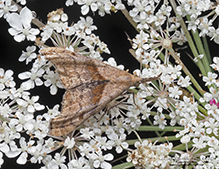 |
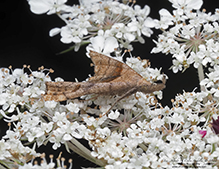 |
||||
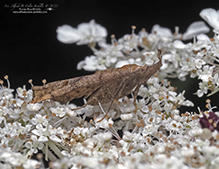 |
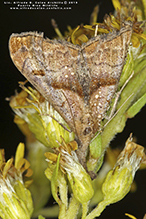 |
||||
MinnesotaSeasons.com Photos |
|||||
|
|||||

Slideshows |
||

Visitor Videos |
|||
Share your video of this insect. |
|||
| This button not working for you? Simply email us at info@MinnesotaSeasons.com. Attach a video, a YouTube link, or a cloud storage link. |
|||
Other Videos |
|||
| Palthis angulalis wetvideocamera |
|||
About
Jul 7, 2014 The Dark-spotted Palthis Moth. Seen high on a wall and videoed with a monopod. Burnaby, BC July 7, 2014 |
|||

Created: 12/16/2020
Last Updated:
